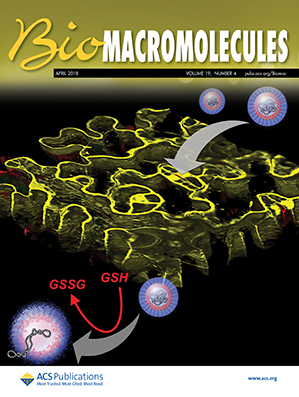Water-Soluble Unconventional Hyperbranched Polyborosiloxane Derivatives for Temperature Sensing in Living Cells
IF 5.4
2区 化学
Q1 BIOCHEMISTRY & MOLECULAR BIOLOGY
引用次数: 0
Abstract
Fluorescent polymeric thermometers, despite their noninvasive detection and rapid response for intracellular temperature monitoring, face challenges in achieving excellent biocompatibility and high sensitivity. Herein, we synthesized a water-soluble unconventional temperature-sensitive fluorescent polymer (P2) through terminally grafting poly(N-vinylcaprolactam) (PNVCL) onto hyperbranched polyborosiloxane (P1). The P2 exhibited efficient red-light emission and good photostability. Particularly, when the temperature rises, the PNVCL units transform from hydrophilic to hydrophobic, resulting in the dislocation of local segments of P2, suppressing radiative transitions and simultaneously weakening its through-space conjugation, further reducing its fluorescence intensity, and endowing the P2 with a high temperature-sensing sensitivity of 10.06% °C–1. Finally, the real-time monitoring of intracellular temperature variation was further conducted. This work not only develops promising thermochromic materials for intracellular temperature sensing but also provides further insight into the temperature-sensing mechanism of unconventional fluorescent polymers.
- Download: Download high-res image (223KB)
- Download: Download full-size image
水溶性非常规超支化聚硼硅氧烷衍生物在活细胞中的温度传感。
荧光聚合物体温计虽然在细胞内温度监测方面具有无创检测和快速响应的特点,但在实现良好的生物相容性和高灵敏度方面仍面临挑战。本文通过端接枝聚(n -乙烯基己内酰胺)(PNVCL)到超支化聚硼硅氧烷(P1)上,合成了一种水溶性非常规温度敏感荧光聚合物(P2)。P2具有良好的红光发射和光稳定性。特别是当温度升高时,PNVCL单元由亲水性转变为疏水性,导致P2局部片段位错,抑制了辐射跃迁,同时削弱了其穿过空间的共轭作用,进一步降低了其荧光强度,使P2具有10.06%°C-1的高温感温灵敏度。最后,进一步实时监测细胞内温度变化。这项工作不仅为细胞内温度传感开发了有前途的热致变色材料,而且为非常规荧光聚合物的温度传感机制提供了进一步的见解。
本文章由计算机程序翻译,如有差异,请以英文原文为准。
求助全文
约1分钟内获得全文
求助全文
来源期刊

Biomacromolecules
化学-高分子科学
CiteScore
10.60
自引率
4.80%
发文量
417
审稿时长
1.6 months
期刊介绍:
Biomacromolecules is a leading forum for the dissemination of cutting-edge research at the interface of polymer science and biology. Submissions to Biomacromolecules should contain strong elements of innovation in terms of macromolecular design, synthesis and characterization, or in the application of polymer materials to biology and medicine.
Topics covered by Biomacromolecules include, but are not exclusively limited to: sustainable polymers, polymers based on natural and renewable resources, degradable polymers, polymer conjugates, polymeric drugs, polymers in biocatalysis, biomacromolecular assembly, biomimetic polymers, polymer-biomineral hybrids, biomimetic-polymer processing, polymer recycling, bioactive polymer surfaces, original polymer design for biomedical applications such as immunotherapy, drug delivery, gene delivery, antimicrobial applications, diagnostic imaging and biosensing, polymers in tissue engineering and regenerative medicine, polymeric scaffolds and hydrogels for cell culture and delivery.
 求助内容:
求助内容: 应助结果提醒方式:
应助结果提醒方式:


